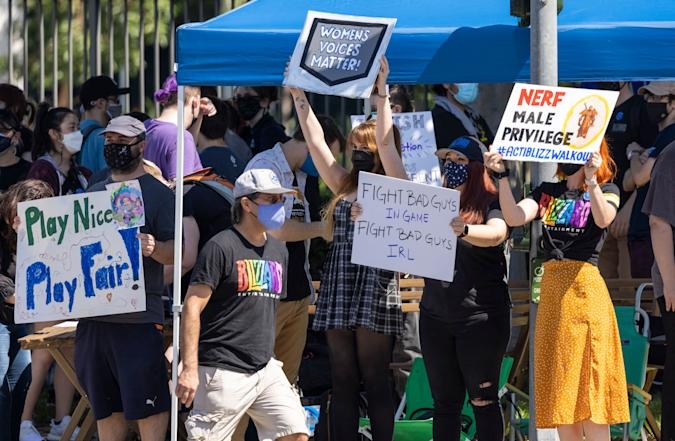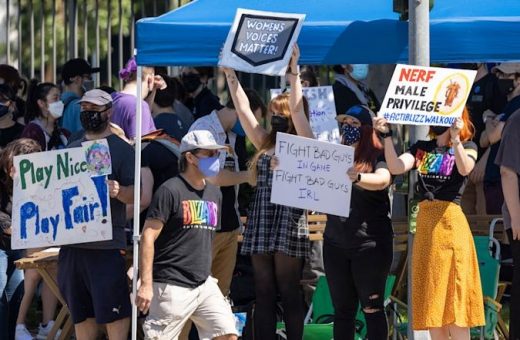Bungie responds to report on its lackluster efforts to improve workplace culture
Inside the sexual harassment lawsuit at Activision Blizzard
A lot has happened in just two weeks, and the filings are piling up.


When California’s fair employment agency sued Activision Blizzard, one of the largest video game studios in the world, on July 20th, it wasn’t surprising to hear the allegations of systemic gender discrimination and sexual harassment at the company. It wasn’t a shock to read about male executives groping their female colleagues, or loudly joking about rape in the office, or completely ignoring women for promotions. What was surprising was that California wanted to investigate Activision Blizzard at all, considering these issues have seemingly been present since its founding in 1979.
Activision Blizzard is a multibillion-dollar publisher with 9,500 employees and a roster of legendary franchises, including Call of Duty, Overwatch, Diablo and World of Warcraft. On July 20th, California’s Department of Fair Employment and Housing filed a lawsuit against Activision Blizzard, alleging executives had fostered an environment of misogyny and frat-boy rule for years, violating equal pay laws and labor codes along the way. This is about more than dirty jokes in the break room — the lawsuit highlights clear disparities in hiring, compensation and professional growth between men and women at Activision Blizzard, and it paints a picture of pervasive sexism and outright abuse in the workplace.
Here’s a rundown of some of the allegations:
-
Just 20 percent of all Activision Blizzard employees are women.
-
Top leadership roles are filled solely by white men.
-
Across the company, women are paid less, promoted slower and fired faster than men.
-
HR and executives fail to take complaints of harassment seriously.
-
Women of color in particular are micromanaged and overlooked for promotions.
-
A pervasive frat-boy culture encourages behavior like “cube crawls,” where male employees grope and sexually harass female co-workers at their desks.
It’s been a few weeks since the lawsuit was filed, and employees, executives and players have all had a chance to respond. Meanwhile, additional reports of longstanding harassment and sexism at Activision Blizzard have continued to roll out, including photos and stories of the “Cosby Suite,” which was specifically named in the filing. According to the lawsuit, this was a hotel room where male employees would gather to harass women at company events, named after the rapist Bill Cosby.
Days after the filing, Kotaku published photos of the supposed Cosby Suite, showing male Activision Blizzard developers posing on a bed with a framed photo of Bill Cosby at BlizzCon 2013. Screenshots of conversations among the developers discussed gathering “hot chixx for the Coz” and other insulting, immature things (especially when you remember these are middle-aged men, not middle-schoolers).
One of the only executives actually named in the suit was Blizzard head J. Allen Brack, and it alleges he routinely ignored systemic harassment and failed to punish abusers. Brack called the allegations “extremely troubling,” but this line was thrown back in his face on Twitter when independent developer Nels Anderson compared it to a video out of BlizzCon 2010, featuring Brack on the far left.
In the video, a young woman asks the panel of World of Warcraft developers, all six of whom are white men, whether they’ll ever create a female character that doesn’t look like she just stepped out of a Victoria’s Secret catalog. The panelists laugh and one responds, “Which catalog would you like them to step out of?” They proceed to essentially dismiss her question. At the end of the exchange, Brack piles on and makes a joke about one of the new characters coming from a sexy cow catalog.
On August 3rd, just two weeks after California filed its lawsuit, Brack stepped down from his role as the president of Blizzard. In his place will be GM Mike Ybarra and executive development VP Jen Oneal. Oneal will be the first woman in a president role since Activision’s founding in 1979; the lawsuit notes that there has never been a non-white president or CEO of Activision Blizzard.
Activision Blizzard’s initial response to the lawsuit was tragic, with one leader calling the allegations meritless and distorted. Activision Blizzard CEO Bobby Kotick, who regularly gets into fights with shareholders over the ridiculous fortune he’s amassed, published his own response to the lawsuit, where he essentially promised to listen better. Unsurprisingly, this didn’t alleviate many employees’ concerns. A petition in support of the lawsuit ended up gathering more than 2,000 employee signatures, and workers organized a walk-out just eight days after the filing, calling for systemic change at the studio.
Shareholders weren’t bolstered by Kotick’s response, either. Investors filed an additional class-action lawsuit against Activision Blizzard on August 3rd, alleging the company failed to raise potential regulatory issues stemming from its discriminatory culture. Blizzard’s head of HR, Jesse Meschuk, also left the company in the weeks following the initial lawsuit.
Meanwhile, other major game developers have rallied behind the suit, and former Activision Blizzard leaders have shared their support for employees, apologizing for their parts in sustaining a toxic company culture.
None of this is new. As evidenced by the photos, videos, stats and personal stories flowing out of Activision Blizzard, the company has operated on a bro-first basis for decades, and honestly, it’s been sustained by an industry that largely functions the same way.
In 2019, a wave of accusations against prominent male developers crashed over the industry, and AAA studios like Ubisoft and Riot Games made headlines for fostering toxic workplace environments. California is currently suing Riot over allegations of sexual harassment and gender discrimination in hiring and pay practices.
But even that’s not new. Women, non-binary people and marginalized folks in the video game industry have been speaking up about systemic harassment and discrimination for literal decades. Sexism is apparent in the hiring and pay habits of many major studios, and it’s also clear in the games themselves, which feature an overabundance of straight, white, male protagonists.
What is surprising, this time around, is that the lawsuit against Activision Blizzard kind of came out of nowhere. It took a blockbuster media report to make California sue Riot in 2020, but the lawsuit against Activision Blizzard appeared on its own, after years of quiet investigation by the Department of Fair Employment and Housing. If sexism is systemic in the video game industry, it feels like the system is finally fighting back.
(45)


